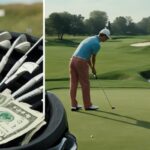- 7 Top Flite Golf Clubs XL for Improved Performance - September 28, 2024
- Top Flite Golf Clubs: Top 5 Reasons to Choose Them - September 28, 2024
- Top 3 Golf Club Fitters for a Perfect Swing - September 28, 2024
You own a golf club that's been collecting dust in your attic or garage, and you're wondering if it's worth more than just a nostalgic trip down memory lane. The answer is yes, but it depends on several factors. The brand, designer, and condition of the club play a significant role in determining its value. Rarity, authenticity, and historical significance also impact its worth. Limited edition clubs, certified vintage models, and those used by famous golfers can command high prices. Researching the club's maker, model, and provenance can help you understand its value. Now, discover the secrets to revealing your club's true potential.
Key Takeaways
- The value of a golf club is heavily influenced by its brand, condition, and rarity, with exclusive clubs commanding higher prices.
- Authenticity is vital, with clubs from high-quality brands and those featuring unique serial numbers or markings being highly prized.
- Certified vintage models, particularly those from the 18th and 19th centuries, are extremely valuable due to their rarity and historical importance.
- The historical significance of a golf club, such as its association with legendary golfers or championships, can significantly increase its value.
- Rare and limited edition golf clubs, such as those made with unique materials or featuring patented features, can sell for tens of thousands of dollars.
Valuing Your Vintage Golf Clubs
When evaluating the value of your vintage golf clubs, it's essential that you weigh a combination of factors, including rarity, authenticity, history, brand, and designer, as these elements greatly impact the club's worth.
The brand and designer of the club play a significant role in determining its value. Clubs from high-quality brands like Army and Navy, Dunn, Gray, White, Forgan, Anderson, and Carrick are highly sought after by collectors.
Additionally, the condition of your vintage golf clubs is vital to their value. Rust-free metal heads and shafts, straight wooden shafts, and intact leather grips are highly prized by collectors.
As you assess your clubs, pay close attention to their overall condition, cleanliness, and originality. A well-maintained club with its original features intact will generally be more valuable than one that's worn or damaged.
Rarity and Authenticity Matters
As you evaluate the value of your golf clubs, you'll want to focus on the rarity and authenticity of your collection.
Limited edition clubs, certified vintage models, and a provenance verification process can substantially impact the worth of your golf clubs.
Limited Edition Clubs
High-end collectors and enthusiasts are willing to pay top dollar for limited edition golf clubs that boast unique features, rarity, and authenticity, making these exclusive pieces highly sought after in the golfing community.
As you explore the world of limited edition clubs, you'll discover that rarity is a key indicator of value. Three key factors that contribute to the value of these exclusive clubs are:
Unique materials and features: Limited edition clubs often feature rare materials, such as wooden heads or smooth face irons, which increase their value.
Authenticity: Clubs from high-quality brands like Army and Navy, Dunn, Gray, White, Forgan, Anderson, and Carrick are highly sought after, and limited edition clubs often bear unique serial numbers or markings to verify their authenticity.
Exclusivity: The value of limited edition golf clubs is often tied to their rarity, with clubs from renowned manufacturers and those featuring unique designs or materials commanding higher prices due to their exclusivity.
The Anderson Dicken Putter from the 1700s, for example, sold for $181,000, highlighting the significant value that rare and limited edition golf clubs can command.
Even modern limited edition clubs, like the Golden Putter First Lady Special Edition made with 24-carat gold, can sell for as much as $150,000.
Certified Vintage Models
Certified vintage models, particularly those from the 18th and 19th centuries, can be extremely valuable due to their rarity and historical importance.
As you explore the world of vintage golf clubs, you'll discover that authenticity is vital. High-quality brands like Army and Navy, Dunn, and Forgan are highly sought after, and verified provenance can substantially increase their worth.
The rarity of a club's features, such as unique head shapes, smooth face irons, and patented features, can greatly impact its value. Specialized clubs like putters and wedges are particularly desirable, and those made from rare materials like hickory golf or persimmon can command high prices.
If you're lucky enough to own a club used by a famous golfer or in a significant tournament, its value can increase exponentially. To get a rough estimate of your club's worth, consider having a professional verify its authenticity and value, using recently sold clubs of similar rarity and condition as a benchmark.
Provenance Verification Process
When evaluating the value of your golf club, verifying its provenance is a critical step that can make all the difference in determining its authenticity and worth. You need to uncover the club's history, including its ownership and usage, to understand its significance and rarity. This process can greatly impact the club's value, especially if it's been used by famous golfers or in significant tournaments.
To verify the provenance of your golf club, follow these steps:
- Research the club's maker: Look into the brand and designer of the club, such as Sayers and St Andrews Golf Co., to understand its quality and reputation.
- Compare to recently sold clubs: Analyze similar clubs that have been sold recently to determine a fair market value for your club.
- Get a professional appraisal: Have a professional appraiser examine the club's materials, unique features, and condition to provide a rough estimate of its worth.
Historical Significance of Golf Clubs
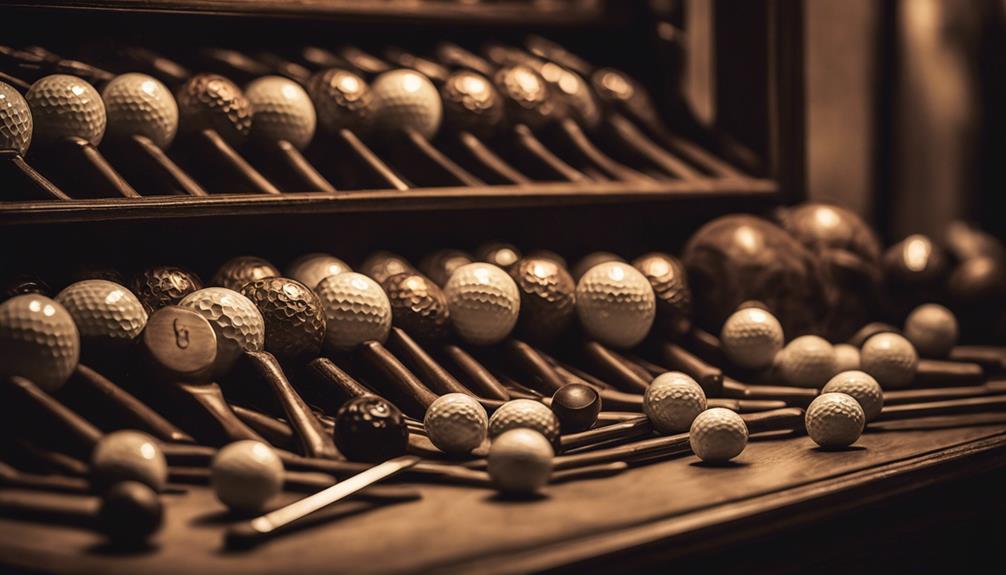
As you venture into the world of golf clubs, it becomes clear that their historical significance stems from their association with legendary golfers, championships, and eras, making them valuable to collectors and enthusiasts.
The earliest golf clubs, dating back to 18th-century Scotland, featured wooden shafts and iron heads, with rare examples selling for up to $181,000. Antique golf clubs, particularly those with unique designs, materials, or craftsmanship, are highly valuable due to their historical significance and rarity.
The 'Long-Nosed Putter' and 'Bulldog' putter, circa 1800s and 1900s respectively, are highly sought-after examples, selling for up to $100,000 and $50,000.
You'll find that vintage golf clubs used by famous golfers, such as Bobby Jones, are highly prized and valuable due to their historical significance and provenance.
The historical significance of golf clubs is directly tied to their connection to legendary golfers, championships, and eras, making them valuable to collectors and enthusiasts.
As you explore further, you'll discover that the rarity and historical significance of these clubs drive their value, making them a coveted possession for those who appreciate the game's rich history.
Club Maker and Model Impact
The brand and designer of a golf club greatly impact its value, with high-quality brands like Sayers and St Andrews Golf Co. being sought after by collectors and enthusiasts. You may have a valuable club in your hands if it's made by a renowned manufacturer.
Three key factors determine the value of a golf club:
Manufacturer reputation: Clubs made by Spalding and MacGregor are highly valuable due to their rarity, craftsmanship, and historical importance.
Model uniqueness: The model of the club, including unique head shapes and patented features, can also affect its value. For example, the Cossar Club's patented features make it a rare and valuable find.
Authenticity and condition: The verification of the club's authenticity by a professional is vital in determining its value. Additionally, the condition and originality of the club, including its grip, shaft, and head, can also impact its value.
When evaluating the worth of your golf club, keep in mind these factors to determine its true value. Remember, a high-quality brand and unique model features can greatly enhance the club's worth.
Comparing Recently Sold Clubs
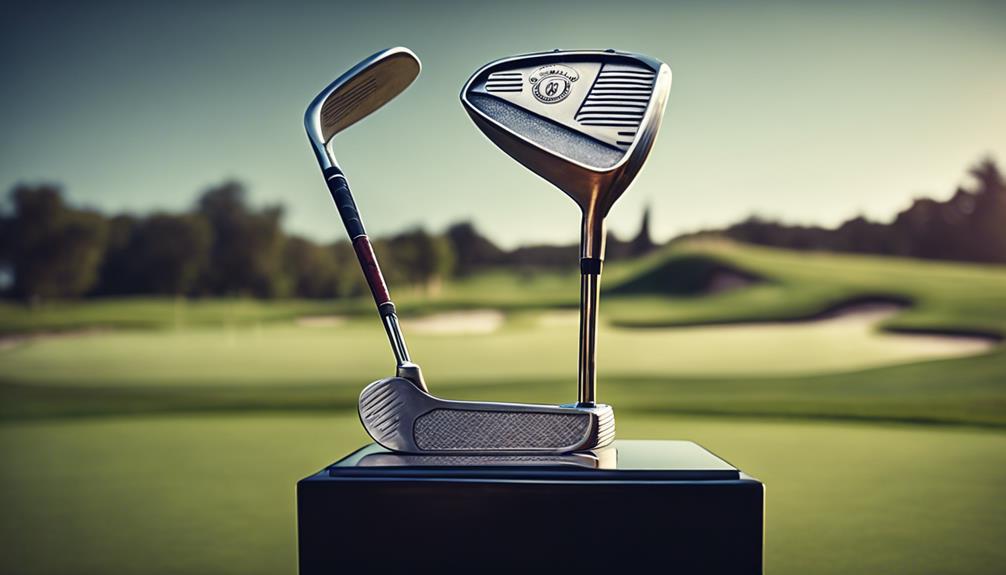
You can gauge the value of your golf club by examining the prices of recently sold vintage clubs, which have fetched tens of thousands of dollars at auctions. Compare with recently sold clubs to get an idea of their worth.
The Anderson Dicken Putter from the 1700s, for instance, sold for a staggering $181,000, making it one of the highest-valued vintage golf clubs ever sold. The Simon-Cosser Putter from the 17th century wasn't far behind, selling for $165,000. These sales demonstrate the high demand for rare and historic golf clubs.
Other recently sold clubs include the Squire Toe Lined Iron Golf Club from the 17th century, which sold for $151,000, and the Golden Putter First Lady Special Edition, made with 24-carat gold, which sold for $150,000.
The Long-Nosed Scarped Golf Club from the 1800s sold for $91,000, illustrating the value of rare and historic golf clubs from the 19th century.
Highest Value Vintage Golf Clubs
Among the most coveted vintage golf clubs are those that have commanded exceptionally high prices at auction, with sales figures reaching into the hundreds of thousands of dollars. As you explore the world of collectible golf clubs, you'll discover that rarity, historical significance, and unique features drive their value.
- The Anderson Dutter: Sold for $181,000, this 1700s putter is one of the highest-valued vintage golf clubs ever sold.
- The Simon-Cosser Putter: This 17th-century putter fetched $165,000, highlighting the significant value of rare and antique golf clubs.
- The Squire Toe Lined Iron Golf Club: Sold for $151,000, this 17th-century club demonstrates the high demand for vintage golf clubs with unique features and historical significance.
These exceptional sales figures underscore the collectible value of vintage golf clubs. When it comes to determining their worth, factors like age, condition, and provenance play a vital role.
As you venture deeper into the world of vintage golf clubs, you'll discover that their value lies not only in their historical significance but also in their rarity and craftsmanship.
Common Vs Rare Golf Clubs
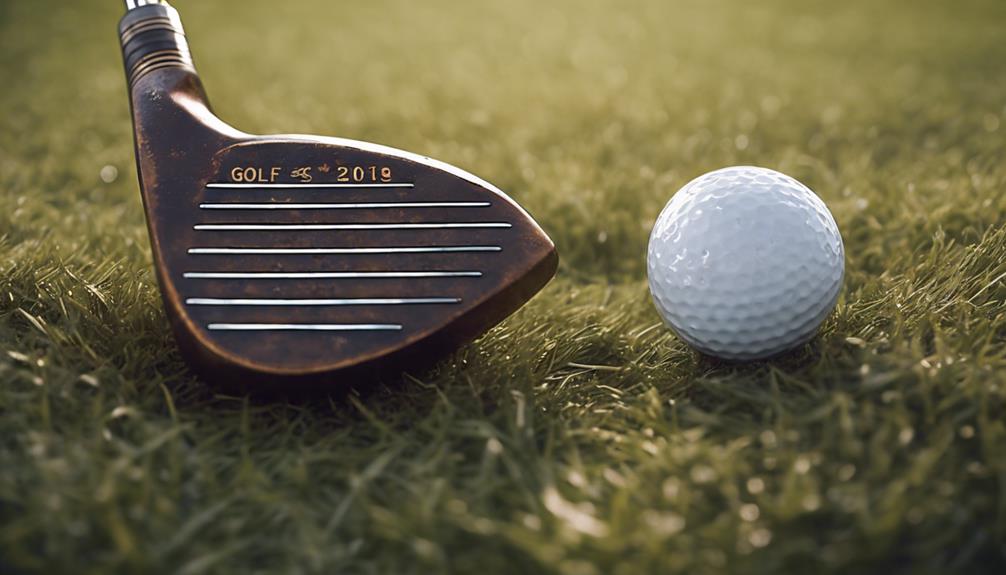
Golf club enthusiasts often find themselves distinguishing between common, mass-produced clubs and rare, highly sought-after specimens, which can greatly impact their monetary value.
As you navigate the market, you'll notice that rare and sought-after clubs typically hail from the 18th and 19th centuries, originating from England or Scotland. These clubs fetch high prices due to their limited supply and historical significance.
On the other hand, common vintage golf clubs are often mass-produced and can be found at yard sales or online, holding little to no monetary value beyond their functional use.
When evaluating a set of clubs, consider the condition, brand, and designer.
Clubs in good condition, with minimal wear and tear, are generally more valuable than those that are damaged or show signs of heavy use.
High-quality brands like Army and Navy, Dunn, Gray, White, Forgan, Anderson, and Carrick are sought after by collectors and enthusiasts, increasing their value.
Specialty clubs like putters and wedges are always desirable, especially if they feature unique materials, craftsmanship, or features.
Determining Antique Club Worth
When evaluating an antique golf club, you'll want to weigh three key factors that heavily impact its worth.
First, you'll need to assess the club maker's reputation, as well-known and respected craftsmen can greatly enhance a club's value.
Additionally, you'll need to examine the club's rarity and condition, as these elements can also heavily influence its overall worth.
Club Maker's Reputation Matters
Determining the worth of an antique golf club starts with researching the club maker's reputation, as it substantially influences the club's value, with esteemed manufacturers like Spalding and MacGregor often commanding top dollar.
As you explore the world of antique golf clubs, you'll find that the club maker's reputation is a vital factor in determining its worth.
Reputation matters: Clubs made by renowned manufacturers like Sayers and St Andrews Golf Co. can profoundly impact the club's value, with some selling for upwards of $181,000.
Authenticity is key: The authenticity of the club, verified by a professional, is essential in establishing its value, as clubs with uncertain provenance are often worth markedly less.
Sought-after clubs stand out: The reputation of the club maker can make a club sought-after, increasing its value and desirability among collectors and enthusiasts.
Rarity Affects Club Value
As you venture into the world of antique golf clubs, you'll find that rarity plays a vital role in driving up a club's value, with unique features, limited editions, and hard-to-find materials sparking intense demand among collectors and enthusiasts.
The rarity of a club can greatly impact its worth, making it a key factor to evaluate when assessing antique golf clubs.
For instance, clubs made from rare materials like hickory or persimmon are highly valuable, especially if they're in good condition and have documented history.
Unique designs, materials, or craftsmanship also drive up a club's value, such as the Long-Nosed Putter, which can sell for up to $100,000.
Limited edition clubs, like the 'Golden Bear', are highly sought after and can command high prices.
To determine a club's rarity, research its history, compare it to recently sold clubs, and verify its authenticity through professional appraisals.
Condition Impacts Worth
Beyond rarity, the condition of an antique golf club substantially influences its worth, and you'll need to carefully inspect the club's physical state to accurately assess its value.
Even if a club is rare, its condition can greatly impact its worth. For instance, a club with significant damage or restoration can decrease its value, while a club in excellent condition can increase its worth.
To evaluate the condition of an antique golf club, consider the following factors:
- Original components: Are all original parts, such as the shaft, grip, and head, still intact and in good condition?
- Signs of wear: Are there any signs of wear, such as dents, dings, or rust, on the club's surface?
- Restoration: Has the club undergone any restoration, such as repainting or re-shafting, which can impact its originality and value?
Researching Golf Club Value
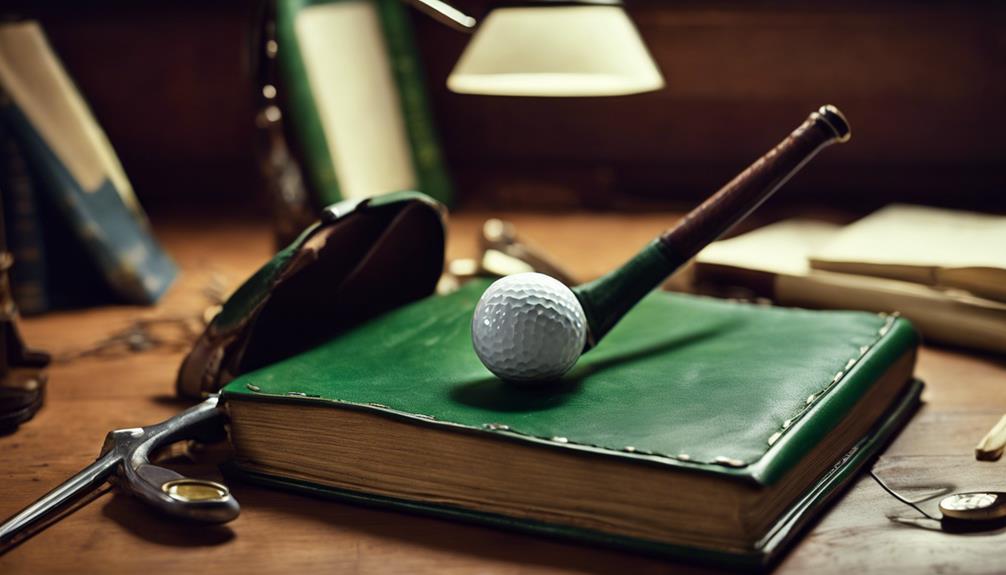
When evaluating the value of a golf club, you should start by identifying its unique features, such as materials, head shape, and patented elements, which can substantially impact its worth.
These features can make your club worth anything, and understanding their significance is essential in determining its value.
Next, research the club's brand and designer, as certain manufacturers are more valuable than others due to their craftsmanship and build quality.
Authenticity is also vital, so consider getting your club professionally verified to provide a rough estimate of its worth.
Supply and demand also play a significant role in determining a club's value.
Look for similar clubs that have recently sold on online marketplaces like eBay or specialized golf forums.
This will give you an idea of the club's market value and help you understand what buyers are willing to pay.
Why Vintage Clubs Are Undervalued
Vintage golf clubs, despite their exceptional craftsmanship and high-quality materials, are often overlooked and undervalued, particularly in comparison to their modern counterparts.
This is largely due to the focus on modern technology, which has led to a lack of recognition for the value of old clubs.
Vintage clubs are often overshadowed by the latest advancements in golf technology, leading to a lack of appreciation for their craftsmanship and historical significance.
The rarity and scarcity of vintage clubs make them more valuable to collectors, but this value isn't widely recognized or reflected in their market price.
The demand for vintage clubs is increasing, particularly among collectors and enthusiasts, but the market for them is still relatively niche and not yet fully appreciated.
As a result, vintage golf clubs are often undervalued, making them a hidden gem for collectors and enthusiasts who recognize their true worth.
Turning Golf Clubs Into Cash
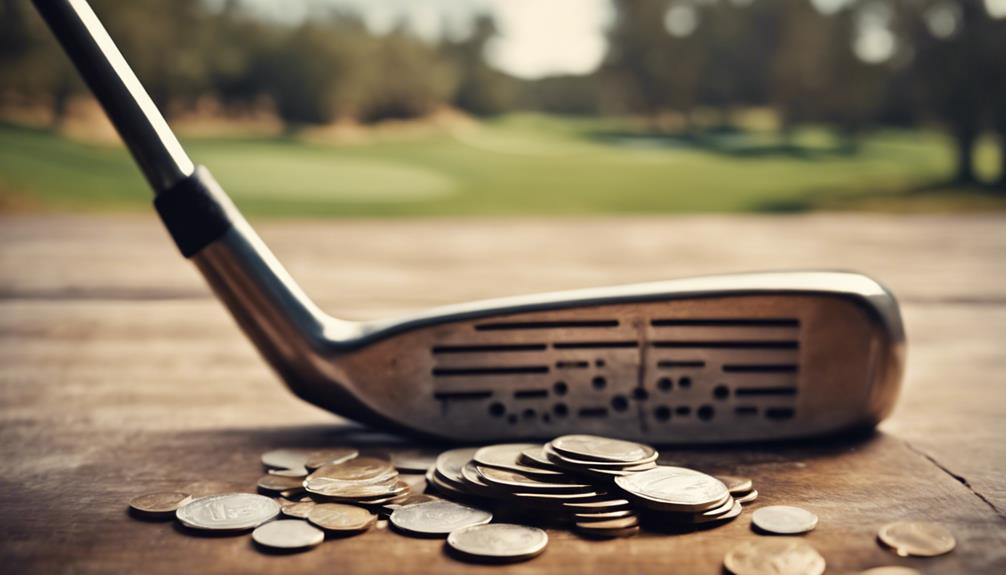
By recognizing the factors that drive their value, collectors and enthusiasts can tap into the hidden cash potential in their vintage golf clubs.
You can really turn your golf clubs into cash by understanding what makes them valuable.
Rare and sought-after clubs from the 18th and 19th centuries, made in England or Scotland, are highly prized.
Early 20th-century American clubs also signal the golf boom, increasing their worth.
Specialty clubs like putters and wedges are always desirable, and a full set, including woods, irons, and canvas bags, is unique and valuable, especially if it's in original condition, clean, and well-cared for.
Clubs with unique designs, materials, or craftsmanship are highly valuable, and those made from rare materials like hickory or persimmon are highly sought after.
Researching the club's history, comparing it to recently sold clubs, and getting expert appraisals can help determine its authenticity and value.
Frequently Asked Questions
How Do I Know if My Golf Clubs Are Valuable?
You examine your golf clubs' value by researching their golf history, inspecting their condition, and verifying authenticity through professionals or documentation, then comparing them to similar sold clubs to determine their market worth.
How Much Are Vintage Golf Clubs Worth?
"As you hold that vintage gem, you wonder how much it's worth. Rarity factors like age, brand, and history spark curiosity, but condition importance reigns supreme – rust-free metal, original leather grips, and straight wooden shafts dictate the final price tag."
Is It Better to Buy Golf Clubs Used?
"When setting your golf budget, consider buying used clubs, as you can find high-quality options that fit your budget, ensuring you get the best club quality for your money, without overspending."
When Did the Ping Eye 2 Come Out?
You're wondering when the Ping Eye 2 innovation emerged, marking a significant milestone in golf innovation and club evolution. Introduced in 1982, this iconic design revolutionized forgiveness and accuracy, forever changing the game.
Conclusion
You've navigated the complex world of valuing vintage golf clubs, and now you're equipped to separate the treasures from the trash.
You know that rarity and authenticity matter, historical significance adds value, and club maker and model impact worth.
By researching recently sold clubs, determining antique club value, and turning clubs into cash, you'll uncover the hidden gems in your collection.
So, dust off those old clubs, and get ready to reap the rewards of your newfound expertise.




